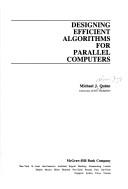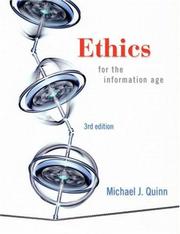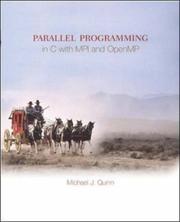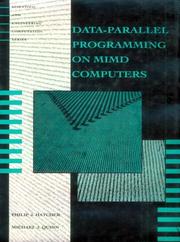| Listing 1 - 8 of 8 |
Sort by
|

ISBN: 0070510717 9780070510715 Year: 1987 Publisher: New York: McGraw-Hill,
Abstract | Keywords | Export | Availability | Bookmark
 Loading...
Loading...Choose an application
- Reference Manager
- EndNote
- RefWorks (Direct export to RefWorks)
Computer science --- Computer architecture. Operating systems --- Algorithms --- Parallel computers --- Algorithmes --- Ordinateurs parallèles --- Programming --- Programmation --- Parallel programming (Computer science) --- Computer algorithms --- 681.3*G4 --- Computer programming --- Parallel processing (Electronic computers) --- Mathematical software: algorithm analysis; certification and testing; efficiency; portability; reliability and robustness; verification --- Computer algorithms. --- Parallel programming (Computer science). --- 681.3*G4 Mathematical software: algorithm analysis; certification and testing; efficiency; portability; reliability and robustness; verification

ISBN: 9780321536853 0321536851 9780321549365 0321549368 Year: 2009 Publisher: Boston : Pearson Addison Wesley,
Abstract | Keywords | Export | Availability | Bookmark
 Loading...
Loading...Choose an application
- Reference Manager
- EndNote
- RefWorks (Direct export to RefWorks)

ISBN: 9780071232654 Year: 2003 Publisher: Boston : McGraw-Hill,
Abstract | Keywords | Export | Availability | Bookmark
 Loading...
Loading...Choose an application
- Reference Manager
- EndNote
- RefWorks (Direct export to RefWorks)
The era of practical parallel programming has arrived, marked by the popularity of the MPI and OpenMP software standards and the emergence of commodity clusters as the hardware platform of choice for an increasing number of organizations. This exciting new book, Parallel Programming in C with MPI and OpenMP addresses the needs of students and professionals who want to learn how to design, analyze, implement, and benchmark parallel programs in C using MPI and/or OpenMP. It introduces a rock-solid design methodology with coverage of the most important MPI functions and OpenMP directives. It also demonstrates, through a wide range of examples, how to develop parallel programs that will execute efficiently on today's parallel platforms.
Book
ISBN: 0321373340 Year: 2006 Publisher: Boston, Mass. Pearson
Abstract | Keywords | Export | Availability | Bookmark
 Loading...
Loading...Choose an application
- Reference Manager
- EndNote
- RefWorks (Direct export to RefWorks)
Professional ethics. Deontology --- Human rights --- Business policy --- Computer architecture. Operating systems --- intellectueel eigendomsrecht --- privacy --- bedrijfsethiek --- netwerken (informatica)

ISBN: 0071232656 Year: 2003 Publisher: New York, NY : McGraw-Hill,
Abstract | Keywords | Export | Availability | Bookmark
 Loading...
Loading...Choose an application
- Reference Manager
- EndNote
- RefWorks (Direct export to RefWorks)

ISBN: 0262082055 9780262288484 9780262082051 0262288486 Year: 1991 Volume: vol *3 Publisher: Cambridge (Mass.) : MIT press,
Abstract | Keywords | Export | Availability | Bookmark
 Loading...
Loading...Choose an application
- Reference Manager
- EndNote
- RefWorks (Direct export to RefWorks)
Data-Parallel Programming demonstrates that architecture-independent parallel programming is possible by describing in detail how programs written in a high-level SIMD programming language may be compiled and efficiently executed-on both shared-memory multiprocessors and distributed-memory multicomputers.MIMD computers are notoriously difficult to program. Data-Parallel Programming demonstrates that architecture-independent parallel programming is possible by describing in detail how programs written in a high-level SIMD programming language may be compiled and efficiently executed-on both shared-memory multiprocessors and distributed-memory multicomputers. The authors provide enough data so that the reader can decide the feasibility of architecture-independent programming in a data-parallel language. For each benchmark program they give the source code listing, absolute execution time on both a multiprocessor and a multicomputer, and a speedup relative to a sequential program. And they often present multiple solutions to the same problem, to better illustrate the strengths and weaknesses of these compilers. The language presented is Dataparallel C, a variant of the original C* language developed by Thinking Machines Corporation for its Connection Machine processor array. Separate chapters describe the compilation of Dataparallel C programs for execution on the Sequent multiprocessor and the Intel and nCUBE hypercubes, respectively. The authors document the performance of these compilers on a variety of benchmark programs and present several case studies.ContentsIntroduction Dataparallel C Programming Language Description Design of a Multicomputer Dataparallel C Compiler Design of a Multiprocessor Dataparallel C Compiler Writing Efficient Programs Benchmarking the Compilers Case Studies Conclusions
C (Computer program language) --- C (Computer programmeertaal) --- C (Langage de programmation) --- Parallel programming (Computer science) --- Parallelle programmering (Informatica) --- Programmation parallèle (Informatique) --- MIMD computers --- Programming --- Programming. --- C (Computer program language). --- Parallel programming (Computer science). --- MIMD computers - Programming. --- Computer programming --- Parallel processing (Electronic computers) --- MIMD computers - Programming --- COMPUTER SCIENCE/High Performance Computing --- Multiple Instruction Multiple Data computers --- Computers
Digital
ISBN: 9780128004807 0128004800 Year: 2015 Publisher: Amsterdam, The Netherlands Elsevier
Abstract | Keywords | Export | Availability | Bookmark
 Loading...
Loading...Choose an application
- Reference Manager
- EndNote
- RefWorks (Direct export to RefWorks)
Wildlife Toxicity Assessments for Chemicals of Military Concern is a compendium of chemical-specific toxicity information with discussions on the rationale and development of Wildlife Toxicity Reference Values (TRVs) intended for use on terrestrial wildlife for risk assessment applications. Substances covered include military-related chemicals including explosives, propellants, pesticides and metals. Wildlife Toxicity Assessments for Chemicals of Military Concern is a much-needed resource designed to meet the needs of those seeking toxicological information for ecological risk assessment p.
Book
ISBN: 9780367754075 9780367754273 9781003162476 Year: 2021 Publisher: Boca Raton, Fla CRC Press, Taylor & Francis Group
Abstract | Keywords | Export | Availability | Bookmark
 Loading...
Loading...Choose an application
- Reference Manager
- EndNote
- RefWorks (Direct export to RefWorks)
| Listing 1 - 8 of 8 |
Sort by
|

 Search
Search Feedback
Feedback About UniCat
About UniCat  Help
Help News
News